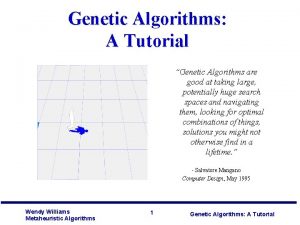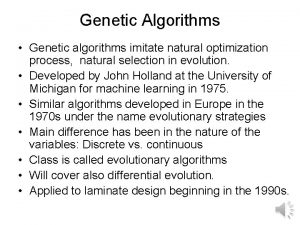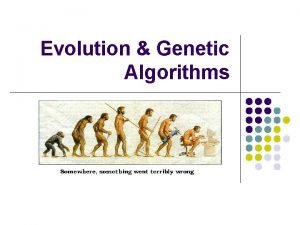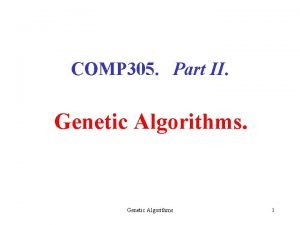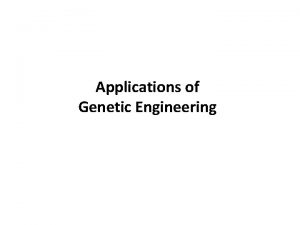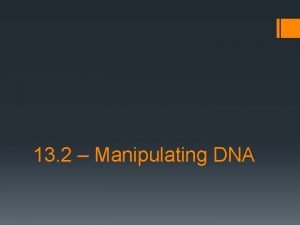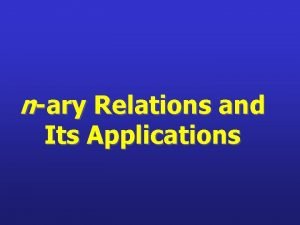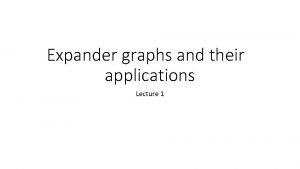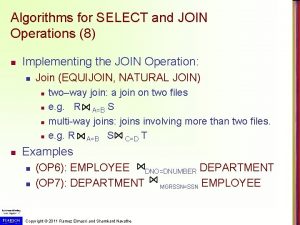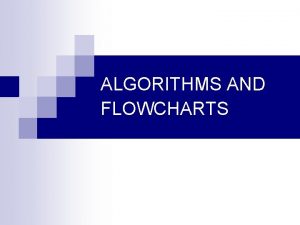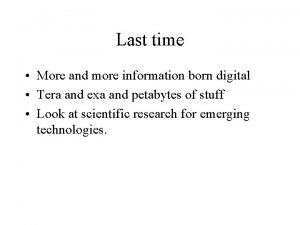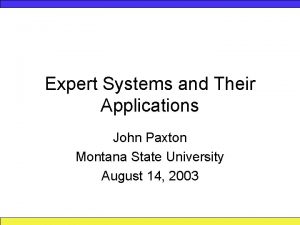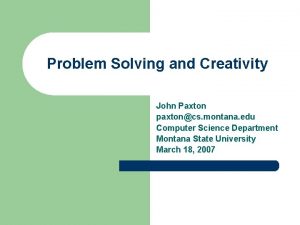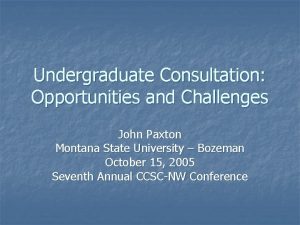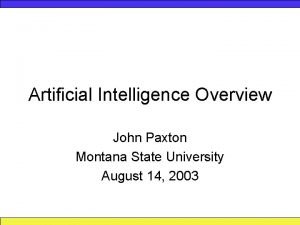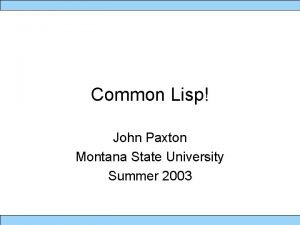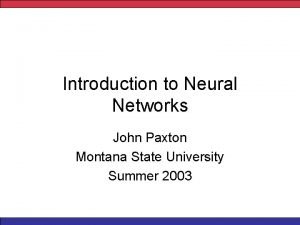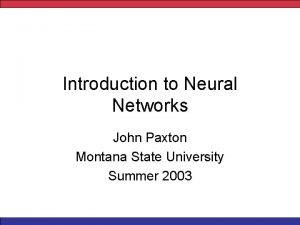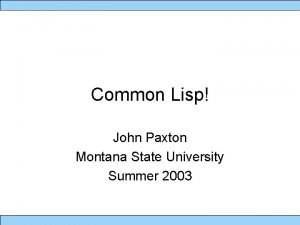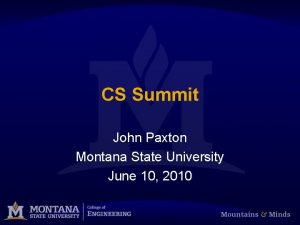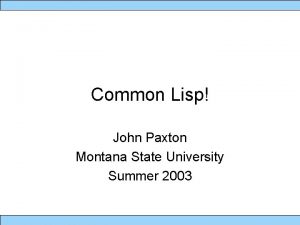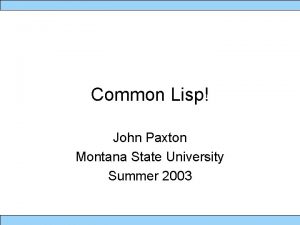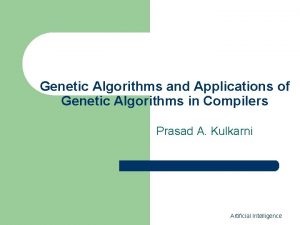Genetic Algorithms and Their Applications John Paxton Montana

































- Slides: 33

Genetic Algorithms and Their Applications John Paxton Montana State University August 14, 2003

Glacier National Park

Natural Evolution • more offspring are produced than can survive • the offspring are not all the same • the offspring best suited to the environment are more likely to survive

Genetic Algorithm 1. Generate a population of chromosomes of size N 2. Calculate the fitness of each chromosome 3. If the termination condition is satisfied, stop. 4. Select a pair of chromosomes for mating 5. With the crossover probability, pc, produce two offspring via crossover.

Genetic Algorithm 6. With the mutation probability, pm, randomly change the gene values in the two offspring. 7. Place the resulting chromosomes in the new population. 8. If the population size is not yet N, go to step 4. 9. Replace the current population with the new population, go to step 2.

Termination Condition • Stop after a set number of generations. • Stop after n generations have passed without “significant” improvement” • Stop after a “good enough” solution has been produced

Representation • Maximize f(x) = 7 x – x 2 where x is an integer in [0. . 7]. • Possible chromosomes: 000, 001, 010, 011, 100, 101, 110, 111

Initial Population • • 010 100 001

Fitness Function Chromosome Fitness (7 x – x 2) 010 10 101 10 000 0 001 6

Selection • Based on fitness of individuals • “Roulette Wheel” selection is very common Fitness 10 Selection Probability 11/30 10 11/30 0 1/30 6 7/30

Crossover Operator • Old – 010 – 101 (fitness 10) • New – 011 – 100 (fitness 12)

Crossover Operator • Crossover is a very effective search technique. • It conducts a parallel search through the most promising building blocks. • Building blocks with above average fitness occur more frequently in the next generation!

Crossover Operator • Fitness Space Generation 1 Generation 2

Convergence • A nasty problem that must be overcome!

Mutation Operator • Old – 011 • New – 001 • Purpose: Genetic Diversity

Mutation Operator Generation 1 Generation 2

Elitism • Copy the n most fit chromosomes from the previous generation into the new one. Typically, n is 1.

Custom Operators • Traveling Salesperson Problem – Chromosome 1: (1 2 3 4 5) – Chromsome 2: (2 4 5 3 1) • Custom Crossover – Chromosome 1: (1 2 4 5 3) – Chromosome 2: (2 4 1 3 5)

Many Decisions • • • Representation of Individuals Population Size Genetic Operators How to Use Operators Stopping Conditions Fitness Function

Genetic Programming • Generation 1 – (* (+ a a) (- a b) 2) – (- 2 a) • Generation 2 – (* 2 (- a b) 2) – (- (+ a a) a)

Genetic Programming • • Select terminals Select primitive functions Define the fitness function Decide on the parameters (crossover probability, etc. ) • Decide the stopping condition

Applications • There are numerous applications of genetic algorithms.

Artificial Life • Framsticks is a three-dimensional life simulation project. Both the physical structure of creatures and their control systems are evolved. Evolutionary algorithms are used with selection, crossover and mutation. Finite element methods are used for simulation. Both spontaneous and directed evolutions are possible.

Biocomputing • Biocomputing, or Bioinformatics, is the field of biology dedicated to the automatic analysis of experimental data (mostly sequencing data). Several approaches to specific biocomputing problems have been described that involve the use of GA, GP and simulated annealing. There are three main domains to which GA have been applied in Bioinformatics: protein folding, RNA folding, sequence alignment.

Cellular Automata • Nature abounds in systems involving the actions of simple, locally- interacting components, that give rise to coordinated global behavior.

Evolvable Hardware • The idea of evolving machines, whose origins can be traced to the cybernetics movement of the 1940 s and the 1950 s, has recently resurged in the form of the nascent field of bio-inspired systems and evolvable hardware.

Game Playing • GAs can be used to evolve behaviors for playing games. Work in evolutionary game theory typically surrounds the evolution of a population of players who meet randomly to play a game in which they each must adopt one of a limited number of moves. • For example, poker.

Job Shop Scheduling • The Job-Shop Scheduling Problem (JSSP) is a very difficult NP- complete problem which, so far, seems best addressed by sophisticated branch and bound search techniques. GA researchers, however, are continuing to make progress on it.

Nonlinear Filtering • New connections between genetic algorithms and Non Linear Filtering Theory have been established. GAs have already been successfully applied to a large class of non-linear filtering problems such as radar / sonar / GPS signal processing. • For example, the military uses GAs to identify radar signals.

Timetabling • This has been addressed quite successfully with GAs. A very common manifestation of this kind of problem is the timetabling of exams or classes in Universities, etc.

Other Applications • Genetic Programming. • Neural Networks. • Jazz. Find good and bad “riffs” for jazz improvisation (Al Biles). • Stock companies. Predict stock market. • Oil pipeline throughput.

Targets for GA Research • Using GAs as general problem solving tools • Finding the “perfect” GA for a given class of problems • Understanding the behavior of GAs • Using GAs for teaching and learning • Using GAs for increasing cooperation between disciplines

Questions?
 Fish morphology worksheet answers
Fish morphology worksheet answers Taylor paxton
Taylor paxton Elaine della donna
Elaine della donna Genetic algorithms tutorial
Genetic algorithms tutorial Genetic algorithms
Genetic algorithms Genetic algorithms
Genetic algorithms Dairy comp 305 tutorial
Dairy comp 305 tutorial Genetic drift definition
Genetic drift definition Genetic programming vs genetic algorithm
Genetic programming vs genetic algorithm Genetic programming vs genetic algorithm
Genetic programming vs genetic algorithm What is the difference between genetic drift and gene flow
What is the difference between genetic drift and gene flow Gene flow vs genetic drift
Gene flow vs genetic drift Genetic engineering
Genetic engineering Grabber
Grabber N-ary relationship example
N-ary relationship example Expander graphs and their applications
Expander graphs and their applications Solid insulating materials and their applications
Solid insulating materials and their applications Lewis and clark county montana
Lewis and clark county montana Prologue act 2 romeo and juliet translation
Prologue act 2 romeo and juliet translation Computational thinking algorithms and programming
Computational thinking algorithms and programming Design and analysis of algorithms syllabus
Design and analysis of algorithms syllabus Ajit diwan iit bombay
Ajit diwan iit bombay Association analysis: basic concepts and algorithms
Association analysis: basic concepts and algorithms Fftooo
Fftooo Princeton data structures and algorithms
Princeton data structures and algorithms Data structures and algorithms tutorial
Data structures and algorithms tutorial Algorithms for select and join operations
Algorithms for select and join operations Algorithms and flowcharts
Algorithms and flowcharts Undecidable problems and unreasonable time algorithms.
Undecidable problems and unreasonable time algorithms. Information retrieval data structures and algorithms
Information retrieval data structures and algorithms Data structures and algorithms bits pilani
Data structures and algorithms bits pilani Cluster analysis: basic concepts and algorithms
Cluster analysis: basic concepts and algorithms Probabilistic analysis and randomized algorithms
Probabilistic analysis and randomized algorithms Introduction of design and analysis of algorithms
Introduction of design and analysis of algorithms



